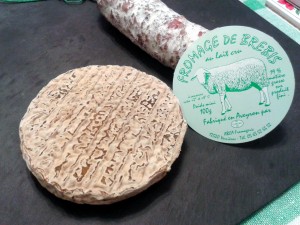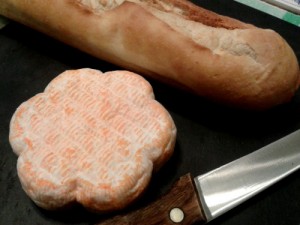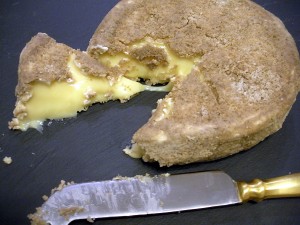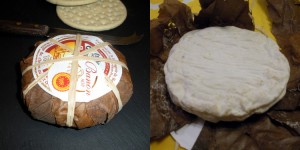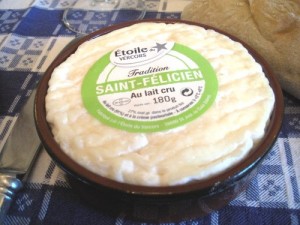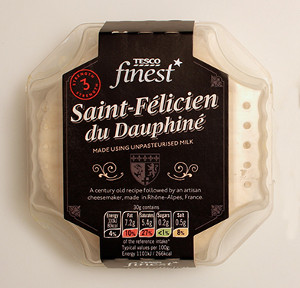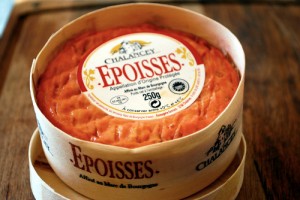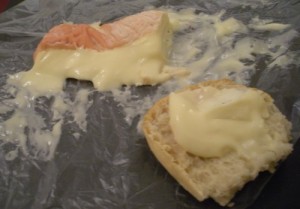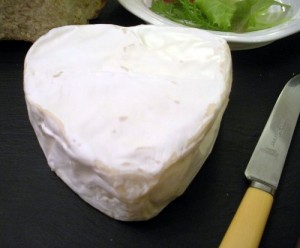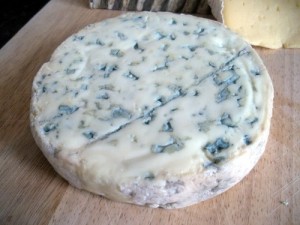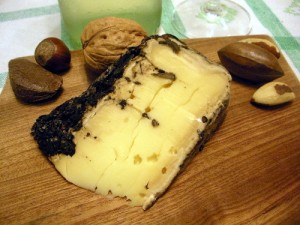Archive for the ‘French’ Category
Pérail de Brebis (aged)
October 11th, 2020 Posted 3:54 pm
We found this for sale in a visiting French market. It was rather crusty and gnarly, so we had to try it.
Normally, Pérail de Bribis is a soft white delicate cheese, but this one was aged, turning into a hard, leathery disc.
The formerly white rind has turned mottled brown and beige. It smells rather like a farm outhouse.
Cutting into it reveals that it has become almost all rind, with a thin layer of soft khaki, grey pate. What little pate remains has a soft, silky texture similar to that of lemon curd..
The flavour is strong and bitter, with a burning spiciness. Not for the feint of heart cheese novice.
It is interesting and pleasant in a masochistic way. Best eaten on toasted fruit bread to counteract some of the bitterness.
Despite the seemingly negative write up, we actually rather liked it.
Reviewed by Nick and Olympia, 2019




 (3.5/5)
(3.5/5)
Posted in 3 Stars - Good, French, Sheep's milk
St. Albray
March 31st, 2019 Posted 7:06 pm
This is one of the first cheeses we ever reviewed. However, we weren’t taking photos at this point. Nearly nine years later, we found some for sale in a visiting French market.
Many years ago, we decided to start taking notes about the various cheeses we had tried. This was one of a handful of cheeses included in that first week’s record. We recorded it as “Petit Tourtain”. Four months later, we reviewed it again under the name “St. Albray”, completely unaware that it was, in fact, the same cheese.
To be honest, we’re still slightly confused about the naming of the cheese. It is understood that St. Albray is the recognised name of the cheese. Normally, it is made in a large 1½Kg form, with the smaller (200g) version being referred to as “petit”. Seeing as the cheese is not protected by AOC status, it is entirely possible that other cheesemakers around France are producing bootleg versions.
The first thing we notice about the cheese is it’s six lobed flower shape. The rind is a pinky / orange colour dusted with white.
The pate is a pale cream colour, soft, slightly rubbery with a waxy texture. It has almost no smell at all.
The taste is very delicate, slightly salty, bittering slightly closer to the rind.
In summary, it’s not a very exciting cheese. The best things about it are the texture and the fact that it’s pretty. It would make a good addition to a cheeseboard for non-cheeselovers.
We have reviewed this cheese three times now, and our opinion hasn’t changed.
Reviewed by Nick & Olympia, 2010 & 2019




 (1.5/5)
(1.5/5)
Posted in 1 Star - Meh, Cow's milk, French, Semi-soft, Washed
Camembert au Calvados
February 10th, 2019 Posted 7:14 pm
Just when you thought Camembert couldn’t get any more interesting…
…they cut off the rind, dip it in a Calvados and cider mixture, and then roll it in biscuit crumb. How wonderful! (Calvados is a brandy made from apples rather than grapes.)
The result is this rather crusty appearance with gooey, yumminess oozing out.
The crust smells very strongly of fermenting fruit with a slight disinfectant smell about it. The pate is typical of a Camembert, pale yellow and gooey with identical creamy, sticky texture.
The taste is an interesting mix of bitter, sweet and fruity with chemical, acetone notes, a bit like pear drops and cellulose varnish. There is also, unsurprisingly, a strong alcoholic element in this mix. The strong aftertaste has a pronounced metallic quality.
In closing, it is an interesting cheese. One to impress guests with, because of it’s unusual and unique nature. As a cheese to savour and enjoy, not so much. It is a little intense, best eaten in small quantities.
Purchased from: Champagne + Fromage, London
Reviewed by Nick & Olympia, 2017




 (3.5/5)
(3.5/5)
Posted in 3 Stars - Good, Cow's milk, French, Soft, Washed
Banon
October 22nd, 2017 Posted 6:27 pm
Brown paper packages, tied up with string, this is one of our favourite things. Like the unassuming gift, wrapped in brown paper, that turns out to be something wonderful, Banon does not disappoint.
This little cheese is wrapped in chestnut leaves, tied up with raffia. Unwrapping reveals a soft, cream coloured cheese with a dusty white mould flecked dark spots from contact with the leaves.
The smell is slightly goaty, musty, with a smell of autumn leaves (unsurprisingly).
The pate is a greyish creamy white with a soft, smooth texture like liquid velvet.
This texture is just wonderful, that velvety pate is orally sensual. The flavour is delicately goaty, slightly nutty, with a slight bitterness. It has a seductive quality that is hard to describe, suffice to say it is ultimately satisfying and very moreish.
Purchased from Champagne + Fromage, London.
Reviewed by Nick & Olympia, 2017




 (5/5)
(5/5)
Posted in 5 Stars - Excellent, French, Goat's milk, Soft
Saint Félicien
March 5th, 2017 Posted 7:58 pm
FREE! terracotta dish with every cheese!… well sometimes.
In France, it is traditional to sell Saint Félicien in shallow terracotta or eathenware dishes, although some manufacturers ship in shallow wooden boxes like a Camembert.
|
The reason for this is that the cheese is prone to becoming extremely runny and leaking whey. It also spoils easily if not allowed to breath. As a result, it doesn’t travel very well, which means it was quite difficult to get hold of. |
|
…and it is really very good. This normally fragile cheese is now easily available throughout the UK, its lush creaminess preserved for all enjoy. Yay!
Saint Félicien is officially categorised as an aged, fresh cheese, which basically means that it’s a couple of weeks old. The very soft yielding rind is a pale yellow, dusted with white mould. The smell is somewhat reminiscent of a freshly talcum powdered baby, sweet with a slight rancid background smell (cue the flood of e-mails from angry mothers). The pate can be almost liquid, requiring a spoon to serve and as it ages, it will also weep quite a lot of whey. Unsurprisingly, for a cheese that could probably be scientifically classified as a liquid, It has a deliciously smooth, creamy texture. The taste is delicate. Sour cream with a slightly fruity tang and nutty edge. As it ages, it will quickly start to become sour and bitter. After too long, it can become quite unpleasant. The trick is to catch it when it just starts to become runny and eat it within a week or two. |
Saint Félicien is one of those classic French cheeses that, until recently, was rarely spotted outside France. Now, thankfully, it has a regular spot on our cheeseboard.
Reviewed by Nick & Olympia, 2013.




 (4/5)
(4/5)
Posted in 4 Stars - Very Good, Cow's milk, French, Soft
Époisses
February 26th, 2017 Posted 8:10 pm
Époisses lays claim to being the smelliest cheese in the world. So smelly and offensive, that open carry is forbidden on the Paris Metro… apparently.
This is how it is presented in shops:
…however, unless you purchase the whole forme, this is how it will appear when you get it home:
The origins of this cheese date back to the 16th century and those naughty Trappist monks putting alcohol in everything. The cheese is washed with a mixture of brandy and brine. Though it is highly unlikely that the monks knew it at the time, a particular strain of bacteria (brevibacterium linens), notably responsible for smelly feet, was a key part of the recipe.
A popular cheese, it continued to be manufactured by many farms in the area. Then due to WW2, production ceased. The recipe was never recorded and only passed on from generation to generation through word of mouth.
Luckily, in 1956, the Berthauts, a couple of farmers near Dijon, had the foresight to revive the cheese and sought out the last surviving individuals who knew how to make it.
Époisses has a sticky orange rind. Did I mention, it’s also rather smelly? Maybe not as bad as expected by its claim of “the world’s smelliest cheese”, but certainly very pungent. Sweaty, smelly socks with a hint of slurry. It sounds horrible but to the hardened cheese connoisseur, it’s heaven (yes, we’re weird like that ![]() ). Sometimes, there is a strong smell of ammonia, but more about that in a moment.
). Sometimes, there is a strong smell of ammonia, but more about that in a moment.
The inner pate is a light creamy colour and should be soft and gooey or runny depending upon ripeness.
The texture is deliciously smooth and creamy and the flavour, perhaps surprisingly, is quite delicate. The pungent aromas are still present in the taste, but very subdued. There is also a wine reaction, that so often occurs with washed cheeses, in the form of delicious fruity notes that magically appear.
A note of warning. Éposses is one of those cheeses that really needs to be stored properly in order to get the best out of it. It is therefore, highly recommended that it be purchased from a proper fromagerie. Supermarkets do sell it, but very often it will lack the expected pungency and gooey decadence. Typically, supermarket sell-by dates are too short for refrigerated storage and the cheese is not fully ripe by the date indicated. In the opposite extreme, it can also become over-ripe and bitter, the aforementioned ammonia smell is a good indicator of this.
Époisses is a real classic cheese that is famous throughout the world. Don’t let bad supermarket experiences put you off, when this cheese is good, it is awesome.
Reviewed by Nick & Olympia, 2012




 (4/5)
(4/5)
Posted in 4 Stars - Very Good, Cow's milk, French, Soft, Washed
Cœur de Neufchâtel
February 12th, 2017 Posted 7:50 pm
Well, it’s St. Valentine’s day (almost) and I’ve been trying, for years, to write up this one at around this time of year, but always missed. Yes, I know… cheesy, but when you have a heart shaped cheese, waddya gonna do?
To be fair, it isn’t the only heart shaped cheese, and Neufchâtel is not always heart shaped. It can be found in other forms, logs, wheels and bricks.
|
Regardless of the shape, Neufchâtel has a soft, smooth, velvety rind, covered in a fine white mould. The smell is very mushroomy with hints of ammonia. The pate is gooey and pale yellow just inside the rind, but almost white and crumbly in the centre. It has a very slight buttery smell that is almost non-existent. The taste is immediately salty, quickly giving way to a pungent flavour accompanied by a burning sensation. There is no real after taste, but it leaves you with the burning and an anæsthetic sensation. It is also one of those cheese that has an interesting effect when taken with wine, producing a strange metallic taste. A bit of a wolf in sheep’s clothing. You think it’s going to be mild mannered, a soft creamy, delicate cheese in a lovely little heart shape. But, then it bites. It’s a bit of an unusual cheese and one to try because of it, but to be honest, it’s a little overrated. |
Purchased from the cheese stall outside Brighton Station.
Reviewed by Nick & Olympia, 2012.




 (1.5/5)
(1.5/5)
Posted in 1 Star - Meh, Cow's milk, French, Soft
Fourme d’Ambert
January 29th, 2017 Posted 6:48 pm
Fourme d’Ambert is one of the oldest known cheeses, dating back to the Roman occupation of France, around 2,000 years ago. The recipe, that is, not the actual cheese which is normally only aged for a month or two.
Traditionally made in a cylindrical “fourme” (French Auvergnat dialect for mould) about 5½” (13cm) diameter and 7½” (19cm) tall, the wheel is unusually tall for its diameter. Usually, it is sold in slices across the wheel rather than wedges.
Soft and yielding, almost spreadable, dusted in a white/grey mould. The pate is off white to dark cream (depending upon age) and flecked with greenish blue. It’s a delightfully appealing cheese from the offset.
The smell is slight, almost non-existent. The texture is deliciously smooth and creamy, yielding pleasantly in the mouth. The flavour likewise is smooth and creamy, delicate with hints of blue. It could be described as similar to a very mellow Roquefort, not so sharp and a lot less salty.
It is a generally pleasant cheese, inoffensive and well behaved. A perfect blue addition to the cheeseboard when you might not want to overwhelm your guests.
Easily available from many supermarkets.
Reviewed by Nick & Olympia, 2011.




 (4/5)
(4/5)
Posted in 4 Stars - Very Good, Blue, Cow's milk, French, Semi-soft
Délice des Crémiers
January 22nd, 2017 Posted 8:04 pm
Rich, tangy, salty, triple cream decadence. A cheese to seriously clog the arteries.
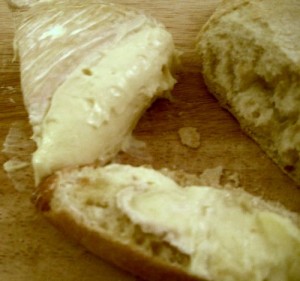 A small round soft cheese with a powdery white dusting of mould, sometimes presented in a simple round wood veneer box.
A small round soft cheese with a powdery white dusting of mould, sometimes presented in a simple round wood veneer box.
The rind smells sharp gathering hints of ammonia as it ages. The pate, soft with an ice cream like texture has the slight acidic smell of sour milk. As it ages the pate closest to the rind becomes soft and gooey separating the rind from the cheese within..
The soft pate melts in the mouth with an instant hit of a sharp, salty, but delicate flavour of sour milk. The flavour quickly fades yielding a softer and pleasing palate that must be savoured.
As it ages, the cheese becomes sharper and more acid, introducing a burn similar to blue cheeses.
All in all a very pleasant cheese, oozing decadence and luxury.
Reviewed by Nick & Olympia, 2012




 (4/5)
(4/5)
Posted in 4 Stars - Very Good, Cow's milk, French, Soft
Tomme au Marc de Rasin
October 25th, 2015 Posted 7:57 pm
It looks a bit like a rather old blackcurrant cheesecake that’s been sitting at the back of the fridge for far longer than it should have, but don’t be put off by its appearance.
|
Topped with the grape seeds and skins left over from wine making (otherwise known a marc). This cheese has a leathery black/grey/brown rind and a light golden waxy looking pate. Not surprisingly, it has the sweet, alcoholic smell of rotting fruit and sour milk. The texture is similar to that of Morbier, but more yielding, almost spreadable. The flavour is strong and robust but not overpowering with mildly alcoholic overtones (a bit like eating cheese with a sip of wine). All in all, a very pleasant cheese that’s a little different. Definitely one for the Christmas cheeseboard. |
Purchased from La Cave à Fromage, Hove.
Reviewed by Nick & Olympia, 2014




 (4/5)
(4/5)
Posted in 4 Stars - Very Good, Cow's milk, French, Hard, Unusual cheese

